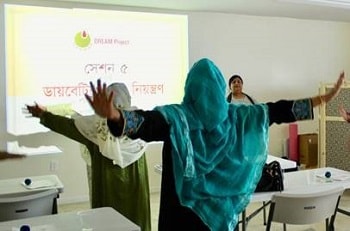DREAM—Diabetes Research, Education, and Action for Minorities
Community Health Workers Assist South Asian Immigrants with Diabetes
New York University-City University of New York (NYU-CUNY)
Prevention Research Center

Can bilingual community health workers improve diabetes patients’ self-management of diabetes with a culturally appropriate approach?
New York University-City University of New York (NYU-CUNY) Prevention Research Center (PRC) researchers assessed whether diabetes educational sessions were effective in managing type 2 diabetes among New York City Bangladeshis. To make the approach culturally appropriate, Community Health Workers who spoke English and Bengali gave the sessions. The goal was to increase knowledge of the disease and self-management among adults, using curriculum materials in Bengali. Bangladeshi and other minority populations face communications barriers with healthcare providers and have limited access to culturally tailored health information.
The 5-year study known as DREAM included 336 Bangladeshi adults aged 31 to 80 years in two comparison groups. During a 6-month period, Community Health Workers led the treatment group in 5 two-hour educational sessions in Bengali. This group also had two 90-minute, one-on-one sessions. The comparison group had only one group educational session with an overview of type 2 diabetes.
Community Involvement
Guided by a group of community members, the study partners included a large public hospital, a federally-funded health center, and social organizations in the Bangladeshi community.
Research Findings
When comparing the changes in knowledge and behavior from the beginning of the study to a follow-up assessment at 6 months, the researchers found:
- The treatment and the control groups both improved their diabetes knowledge and understanding of what A1C is (a measure of blood sugar level). The intervention group, however, had a 46 percentage point greater increase in understanding A1C (62.9 percentage point increase) than the comparison group (16.9 percentage points increase).
- Total weekly physical activity increased for the intervention group but not for the comparison group. The intervention group had a 141 minute greater increase in weekly physical activity than the comparison group.
- The percent of participants having their blood glucose tested at least once a week increased 4.5 percentage points more for the intervention group (10.2 percentage points increase) when compared with the comparison group (5.7% percentage points increase).
Overall, Community Health Worker models that use appropriate language skills may be important in helping immigrant patients improve management of type 2 diabetes. Community Health Workers can provide support to improve diabetes management as effective members of the health care team when immigrant communities have limited English skills. Learn more: see DREAM